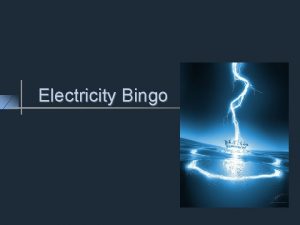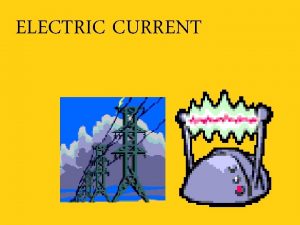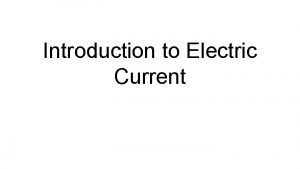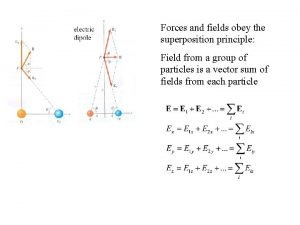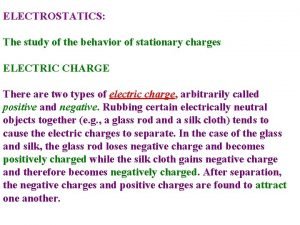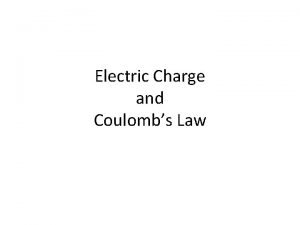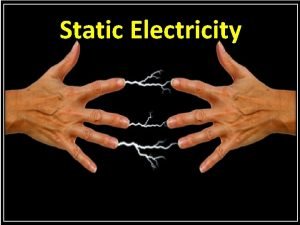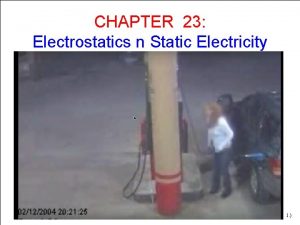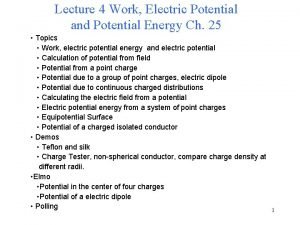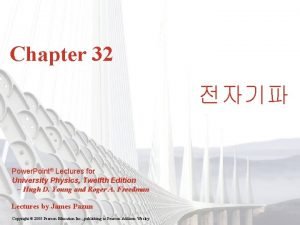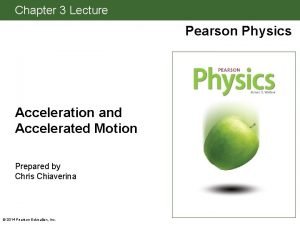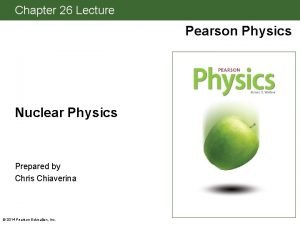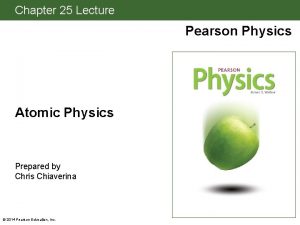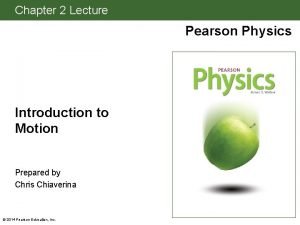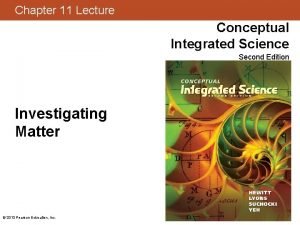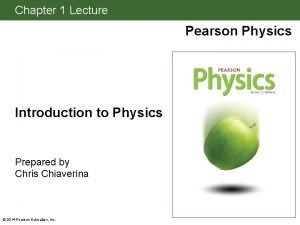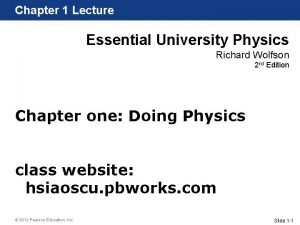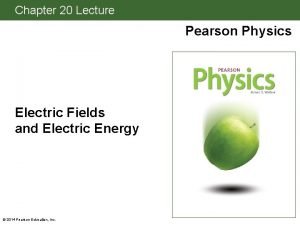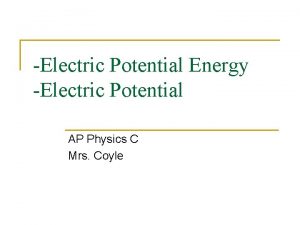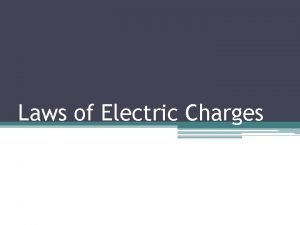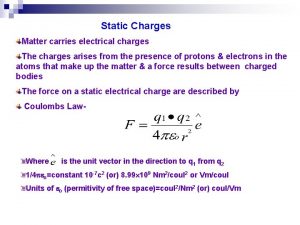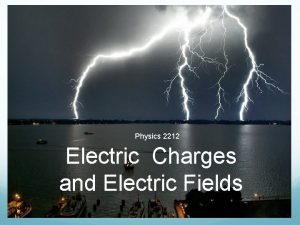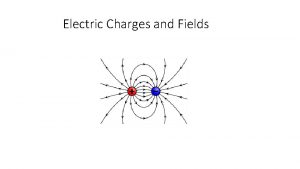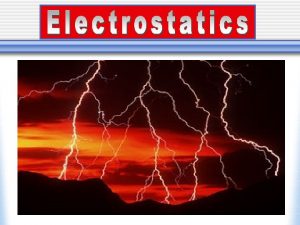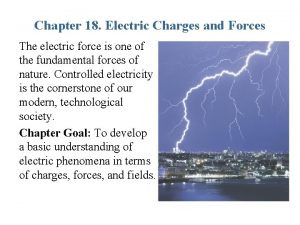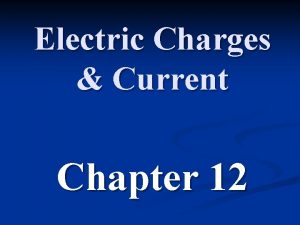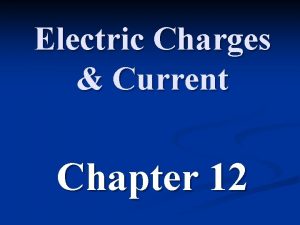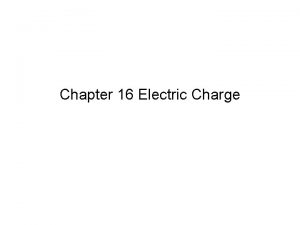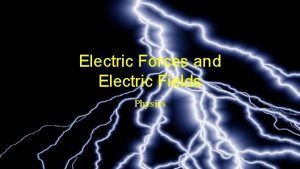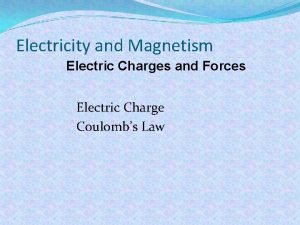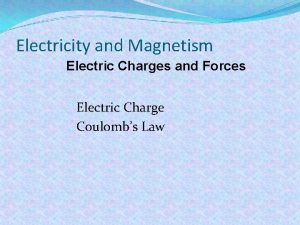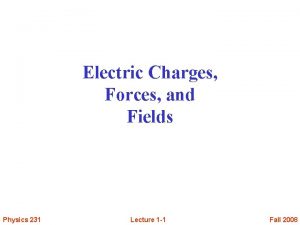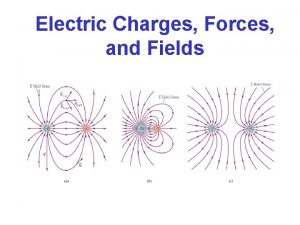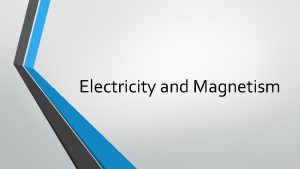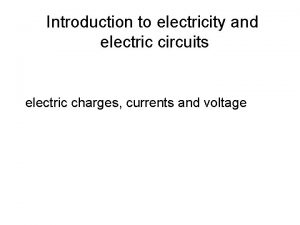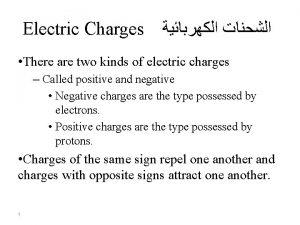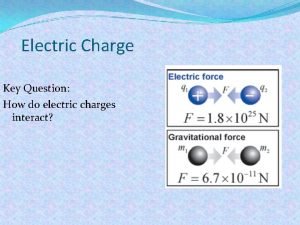Chapter 19 Lecture Pearson Physics Electric Charges and



















































- Slides: 51

Chapter 19 Lecture Pearson Physics Electric Charges and Forces © 2014 Pearson Education, Inc.

Chapter Contents • Electric Charge • Electric Force • Combining Electric Forces © 2014 Pearson Education, Inc.

Electric Charge • Matter is made of electric charges, and electric charges exert forces on one another. • The effects of electric charge have been known since at least 600 B. C. • The Greeks noticed that when rubbed with animal fur, amber—a solid, translucent material formed from the fossilized resin of extinct trees—attracts small, lightweight objects. © 2014 Pearson Education, Inc.

Electric Charge • The figure below shows the charging process as well as the effect a charged amber rod has on scraps of paper. • Electric charge comes in two distinct types. This may be demonstrated with two charged amber rods and a charged glass rod. © 2014 Pearson Education, Inc.

Electric Charge • In the figure below, a charged amber rod is suspended from a string. When another charged amber rod is brought near the suspended rod, it rotates away, indicating a repulsive force. © 2014 Pearson Education, Inc.

Electric Charge • As the figure below indicates, when a charged glass rod is brought close to the suspended amber rod, the amber rod rotates toward the glass, indicating an attractive force. © 2014 Pearson Education, Inc.

Electric Charge • It follows that the charges on the amber and glass must be different. These different types of charge are opposites, as in the familiar expression "opposites attract. " • We know today that the two types of electric charge found on amber and glass are the only types of electric charge that exist. • In 1747, Benjamin Franklin (1706– 1790) proposed that the charge on glass be called positive (+) and the charge on amber be called negative (−). © 2014 Pearson Education, Inc.

Electric Charge • Atoms are electrically neutral. Each atom contains a small, dense nucleus with a positive charge that is surrounded by a "cloud" of electrons with an equal negative charge. • Two types of particles are found in the nucleus: one is positively charged and the other is electrically neutral. © 2014 Pearson Education, Inc.

Electric Charge • Simplified representations of an atom are shown in the following figure. • All electrons have exactly the same charge. The charge on an electron is defined to have a magnitude e equal to 1. 6 x 10− 19 C, where C stands for coulomb, the SI unit of charge. © 2014 Pearson Education, Inc.

Electric Charge • Since electrons have a negative charge, the charge on an electron is –e. This is one of the defining properties of the electron. The other defining property of the electron is its mass, me: me = 9. 11 x 10− 31 kg • In contrast, the charge on a proton—one of the main constituents of the nucleus—is exactly +e. Therefore, the total charge on atoms, which have an equal number of electrons and protons, is precisely zero. © 2014 Pearson Education, Inc.

Electric Charge • The mass of the proton, which is about 2000 times larger than the mass of an electron, is mp = 1. 673 x 10− 27 kg • The neutron is the other main constituent of the nucleus. As its name implies, the neutron has zero charge. Its mass is slightly larger than that of a proton: mn = 1. 675 x 10− 27 kg © 2014 Pearson Education, Inc.

Electric Charge • Since electrons always have the charge –e and protons always have the charge +e, it follows that all objects must have a total charge that is an integer multiple of e. • The fact that electric charge comes in integer multiples of e is referred to as charge quantization. • Charge quantization is key to understanding the behavior of atoms and molecules, for the addition or removal of even a single electron is a significant event for an atom or molecule. © 2014 Pearson Education, Inc.

Electric Charge • A coulomb is a large amount of charge. Since the charge on an electron has a magnitude of only 1. 6 x 10− 19 C, it follows that the number of electrons in a coulomb is 1 C/1. 6 x 10− 19 C = 6. 25 x 1018 electrons • A lightning bolt can deliver 20– 30 coulombs of charge. A more common unit of charge is the microcoulomb, µC, where 1 µC = 10− 6 C. © 2014 Pearson Education, Inc.

Electric Charge • As we have seen, electric charge can be transferred between objects simply by rubbing fur across an piece of amber. This transfer of charge is illustrated in the figure below. • Before charging, the fur and amber are both neutral. During the rubbing process some electrons are transferred from the fur to the amber, giving the amber a negative charge. © 2014 Pearson Education, Inc.

Electric Charge • At the same time the fur acquires a positive charge. • At no time during the process is charge ever created or destroyed. This is an example of one of the fundamental conservation laws of physics: Electric charge is conserved. This means that the total electric charge in the universe is constant. • It should be noted that when charge is transferred from one object to another, it is generally due to movement of electrons. © 2014 Pearson Education, Inc.

Electric Charge • In a typical solid the nuclei of the atoms are fixed in position. The outer electrons of these atoms, however, are weakly bound and easily separated. • As a piece of fur rubs across amber, for example, some of the electrons that were originally a part of the atoms in the fur are separated from those atoms and deposited onto atoms in the amber. © 2014 Pearson Education, Inc.

Electric Charge • An atom that gains or loses electrons is called an ion. More specifically, atoms that lose electrons become positive ions, and atoms that gain electrons become negative ions. This transfer process is referred to as charging by separation. © 2014 Pearson Education, Inc.

Electric Charge • When two materials are rubbed together, the magnitude and sign of the charge each material acquires depend on how strongly that material holds onto its electrons. • For example, if silk is rubbed against glass, the silk acquires a negative charge. If silk is rubbed against amber, however, the silk becomes positively charged. © 2014 Pearson Education, Inc.

Electric Charge • Transferring charge by rubbing objects together is a type of charging by separation known as triboelectric charging. • This type of charging can be understood by referring to the following table. The larger the number of plus signs associated with a material in the table, the more readily it gives up electrons and becomes positively charged. Similarly, the larger the number of minus signs associated with a material, the more readily it acquires electrons and becomes negatively charged. © 2014 Pearson Education, Inc.

Electric Charge • In general, when two materials in the table are rubbed together, the one higher in the list becomes positively charged and the one lower in the list becomes negatively charged. © 2014 Pearson Education, Inc.

Electric Charge • Charge separation occurs not only when one object is rubbed against another, but also when objects collide. For example, collisions of crystals of ice in a rain cloud cause charge separation that can results in bolts of lightning that bring the charges together. • The rotating blades of a helicopter become charged due to the collisions between the blades and dust particles in the air. © 2014 Pearson Education, Inc.

Electric Charge • The charged blades give off sparks that are visible at night (see figure below). • Similarly, particles in the rings of Saturn are constantly undergoing collisions and becoming charged. The Voyager spacecraft recorded electric discharges, similar to lightning bolts on Earth. © 2014 Pearson Education, Inc.

Electric Charge • In addition, the faint radial lines, or spokes, that extend across the rings of Saturn (see figure below) are the result of electric forces between charged particles. © 2014 Pearson Education, Inc.

Electric Charge • We know that charges of opposite sign attract. It is also possible, however, for a charged rod to attract small objects that have zero total charge. The mechanism responsible for this attraction is called polarization. • To see how polarization works, consider the figure below. © 2014 Pearson Education, Inc.

Electric Charge • When a positively charged rod is brought close to a neutral object, the atoms at the surface of the object distort, producing excess negative charge on the surface. The induced charge is referred to as a polarization charge. • Because the polarization charge is opposite that on the rod, there is an attractive force between the rod and the object. • Of course, the same conclusion is reached if we consider a negative rod held near a neutral object. © 2014 Pearson Education, Inc.

Electric Charge • It is for this reason that both charged amber and charged glass attract neutral objects—even though their charges are opposite. • As the figure below indicates, a negatively charged balloon can attract a stream of water, even though the water molecules are electrically neutral. © 2014 Pearson Education, Inc.

Electric Charge • When one end of an amber rod is rubbed with fur, the rubbed portion becomes charged, and the other end remains neutral. The charge does not move from one end to the other. • Materials like amber, in which charges are not free to move, are called insulators. Most insulators are nonmetallic substances, and most are also good thermal insulators. • In contrast, a conductor is a material that allows charges to move freely from one location to another. Most metals are good conductors. © 2014 Pearson Education, Inc.

Electric Charge • The figure below provides examples of insulators and conductors. © 2014 Pearson Education, Inc.

Electric Charge • When an uncharged metal sphere is touched by a charged rod, some charge is transferred at the point of contact [figure (a)]. Because like charges repel and because charges move freely through a conductor, the transferred charge quickly spreads out and covers the entire surface of the sphere [figure (b)]. • The insulating base prevents charge from flowing from the sphere into the ground. © 2014 Pearson Education, Inc.

Electric Charge • On a microscopic level, the difference between conductors and insulators is that the atoms in conductors allow one or more of their outermost electrons to become detached. These detached electrons, often referred to as conduction electrons, can move freely throughout the conductor. • Insulators, in contrast, have very few, if any, free electrons. In an insulator the electrons are bound to their atoms and cannot move from place to place within the material. © 2014 Pearson Education, Inc.

Electric Charge • Since the flow of electric charge can be dangerous to people, insulating gloves like those shown in the figure below are important to the safety of electrical workers. • Materials that have properties intermediate between those of a good conductor and those of a good insulator are referred to as semiconductors. © 2014 Pearson Education, Inc.

Electric Force • Not only do opposite charges attract and like charges repel, but the strength of the attraction or repulsion depends on the magnitude of the charges. • The force between electric charges, which we refer to as the electric or electrostatic force, also depends on the separation between the charges. • Consider two electric charges q 1 and q 2. What Coulomb discovered is that if you double charge q 1, the force doubles. If you double charge q 2, the force again doubles. © 2014 Pearson Education, Inc.

Electric Force • Thus, the electrostatic force depends on the product of the magnitudes of the charges. That is, F depends on |q 1||q 2| • Thus, doubling either charge doubles the force. • Coulomb also discovered that the electric force becomes weaker as the charges are moved farther apart. In fact, he found that if you double the separation between the charges, the force drops off by a factor of 4. Thus, the electrostatic force depends on the inverse square of the distance between the charges. © 2014 Pearson Education, Inc.

Electric Force • Coulomb combined these observations into a law. Coulomb's law relates the strength of the electrostatic force between point charges to the magnitude of the charges and the distance between them: • In this equation, the constant k has the following value: k = 8. 99 x 109 N·m 2/C 2. © 2014 Pearson Education, Inc.

Electric Force • Summarizing: The magnitude of the electric force is given by Coulomb's law. The electric force acts along the line connecting the two charges. In addition, we know that like charges repel and opposite charges attract. • These properties are illustrated in the figure below, where force vectors are shown for pairs of charges of various signs. © 2014 Pearson Education, Inc.

Electric Force • Newton's third law applies to each of the cases shown in the preceding figure. For example, the force exerted on charge 1 by charge 2 is always equal in magnitude and opposite in direction to the force exerted on charge 2 by charge 1. • The following figure illustrates the "opposites attract, likes repel" rule in a dramatic way. © 2014 Pearson Education, Inc.

Electric Force • The Van de Graaff generator charges the student's hair, giving each strand of hair the same charge. The like charges repel, creating the ultimate bad hair day. © 2014 Pearson Education, Inc.

Electric Force • It's interesting to compare Coulomb's law for the electric force and Newton's law for the force of gravity. The equations are as follows: Coulomb's law F = k|q 1||q 2|/r 2 Newton's law of gravity F = km 1 m 2/r 2 • In each case the force decreases as the square of the distance between the objects. In addition, each force depends on the product of two magnitudes of a physical quantity. For electric force the physical quantity is the charge; for gravity it is the mass. © 2014 Pearson Education, Inc.

Electric Force • Because the electric force can be attractive or repulsive, the total electric force between neutral objects, such as the Earth and Moon, is essentially zero. Basically, the attractive and repulsive forces cancel one another out. • This is not the case with gravity, however. Gravity is always attractive, exerting a larger total force on larger astronomical bodies. Thus, the total gravitational force between the Earth and the Moon is not zero. © 2014 Pearson Education, Inc.

Electric Force • Gravity is also behind the formation of black holes—objects whose gravity is so strong that not even light can escape from them. If a star or other object comes too close to a black hole, it will be pulled into the hole, as illustrated in the figure below. © 2014 Pearson Education, Inc.

Electric Force • The electric force rules at the atomic level, where gravity plays essentially no role. To see why, let's compare the electric and gravitational forces between a proton and an electron in a hydrogen atom. • Using Newton's law of gravity, the gravitational force between the proton and electron can be shown to be 3. 36 x 10− 47 N. • Using Coulomb's law, the electric force is found to equal 8. 22 x 10− 8 N. • Taking the ratio of these two forces, we find that the electric force is 2. 26 x 1039 times greater! © 2014 Pearson Education, Inc.

Electric Force • Another indication of the strength of the electric force is given in the following Quick Example. © 2014 Pearson Education, Inc.

Combining Electric Forces • The electric force, like all forces, is a vector quantity. • When a charge experiences forces due to two or more other charges, the total force on it is the vector sum of the individual forces. • Thus, the total force acting on a given charge is the sum of the individual forces between just two charges at a time, with the force between each pair of charges given by Coulomb's law. © 2014 Pearson Education, Inc.

Combining Electric Forces • As an example of combining electric forces, consider the system shown in the figure below. • In this case the total force on charge 1, F 1, is the vector sum of the forces due to charge 2 and charge 3: F 1 = F 12 + F 13 © 2014 Pearson Education, Inc.

Combining Electric Forces • Thus, the electric forces combine by vector addition to give the total force. This addition process is referred to as the superposition of forces. © 2014 Pearson Education, Inc.

Combining Electric Forces • In the following Guided Example, we apply superposition to three charges in a line. © 2014 Pearson Education, Inc.

Combining Electric Forces © 2014 Pearson Education, Inc.

Combining Electric Forces • When the individual forces do not act along a straight line, we start by drawing arrows representing the individual force vectors. The sum of these vectors gives the total force. • The sum can be found using components or graphically by placing the individual force vectors head to tail, and so on. © 2014 Pearson Education, Inc.

Combining Electric Forces • Although Coulomb's law is stated for point charges, it can be applied to spherical charge distributions as well. • For example, suppose a sphere has a charge Q spread evenly over its surface. If a point charge q is outside the sphere, a distance r from its center, then the force between the point charge and the sphere is simply F = k|q||Q|/r 2 • Thus, for charges outside a sphere, a spherical charge distribution behaves as if all the charge were concentrated at its center. Charges inside the sphere experience zero force. © 2014 Pearson Education, Inc.

Combining Electric Forces • When a charge Q is spread evenly over the surface of a sphere, it is convenient to specify the amount of charge per unit area on the sphere. The charge per area is referred to as the surface charge density, σ. • The surface charge density is defined by the following equation: σ = Q/A • It follows that if a sphere has an area A and a surface charge density σ, its total charge is Q = σA • The dimensions of σ are charge per area, or C/m 2. © 2014 Pearson Education, Inc.

Combining Electric Forces • The following example examines the force on a point charge exerted by a spherical charge distribution. © 2014 Pearson Education, Inc.
 Electric charges and electric forces lesson outline
Electric charges and electric forces lesson outline Like charges blank and opposite charges blank
Like charges blank and opposite charges blank Chapter 21 electric charge and electric field
Chapter 21 electric charge and electric field Chapter 21 electric charge and electric field
Chapter 21 electric charge and electric field Electric force
Electric force Dc o/d per item charge
Dc o/d per item charge The net movement of electric
The net movement of electric The figure shows three electric charges labeled
The figure shows three electric charges labeled Continuous flow of electric charges
Continuous flow of electric charges Superposition principle is obeyed by
Superposition principle is obeyed by Study of stationary electric charges is
Study of stationary electric charges is Study of stationary electric charges is
Study of stationary electric charges is Electron charge
Electron charge Electric charges
Electric charges Coulomb's law formula
Coulomb's law formula Electricity flow
Electricity flow 01:640:244 lecture notes - lecture 15: plat, idah, farad
01:640:244 lecture notes - lecture 15: plat, idah, farad Conceptual physics chapter 35 electric circuits
Conceptual physics chapter 35 electric circuits Electricity
Electricity Formula for work done
Formula for work done Electric potential from electric field
Electric potential from electric field Define electrical potential difference
Define electrical potential difference Electric potential lecture
Electric potential lecture Physics 102
Physics 102 Pearson education 2011
Pearson education 2011 2011 pearson education inc
2011 pearson education inc Bob whelan pearson
Bob whelan pearson Educational pearson pearson times
Educational pearson pearson times Pearson education inc publishing as pearson prentice hall
Pearson education inc publishing as pearson prentice hall Pearson education inc. 2012
Pearson education inc. 2012 2008 pearson prentice hall inc
2008 pearson prentice hall inc Potential energy of an electric field
Potential energy of an electric field A suitable electric pump in an electric circuit is a
A suitable electric pump in an electric circuit is a Classical mechanics
Classical mechanics Physics 101 lecture notes pdf
Physics 101 lecture notes pdf Phy101 lecture 1
Phy101 lecture 1 Physics 101 lecture notes pdf
Physics 101 lecture notes pdf Wave motion definition
Wave motion definition Atmospheric physics lecture notes
Atmospheric physics lecture notes Database processing fundamentals design and implementation
Database processing fundamentals design and implementation Pearson physics
Pearson physics Xf=xi+vt
Xf=xi+vt Chain physics
Chain physics Pearson physics
Pearson physics Constant velocity position time graph
Constant velocity position time graph Pearson physics
Pearson physics Pearson physics
Pearson physics Pearson physics
Pearson physics Pearson
Pearson Gcse physics
Gcse physics Ap physics c electric potential
Ap physics c electric potential Modern physics vs classical physics
Modern physics vs classical physics

